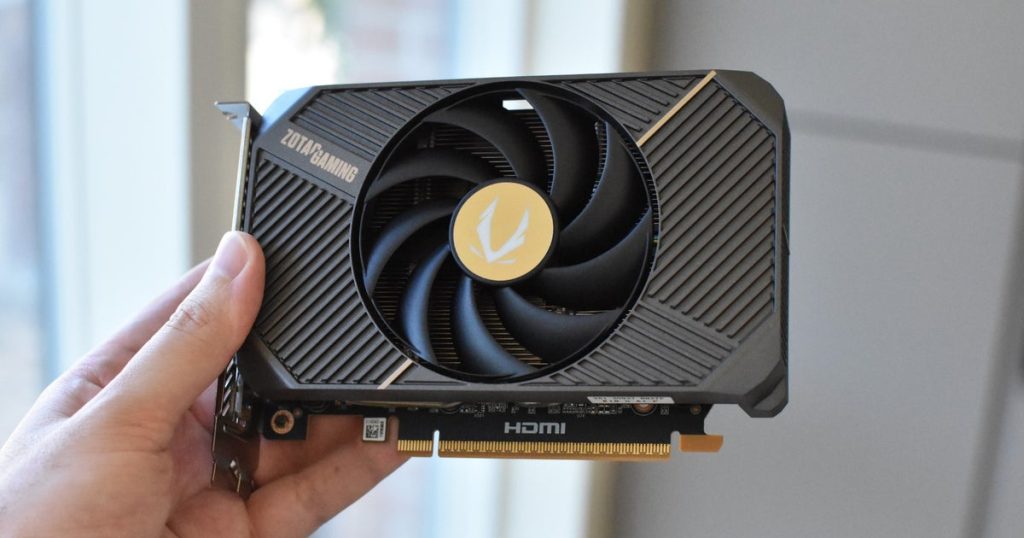I’d so desperately like to do a graphics card review without the fug of a wider controversy (or cacked-up market conditions), but the RTX 50 series hasn’t been particularly cooperative in that regard, so why should the RTX 5060 be any different? This time, the sadness cloud comes wafting from Nvidia themselves, amid accusations of engineering dodgy RTX 5060 previews and attempting to trade access for greater coverage of its Multi Frame Generation (MFG) capability.
Such scheming, if true and intentional, would suggest a remarkable lack of faith in the RTX 5060’s core, un-frame-genned performance. Yet now that I’ve spent some quality time with the card myself – independent of any tit-for-tat preview shenanigans, obviously – it really isn’t that bad, on pure hardware terms. It’s not equipped for cut-price 1440p but as an affordable 1080p pusher, it’s fine. Adequate. Reasonable. Hardly some catastrophe that needs a thunder-running PR offensive to cover up with MFG figures.
The drivers, though? Now there’s a disaster. And not because of the convention-breaking lack of early review software for press hacks – I got access to the RTX 5060’s Game Reader Driver 576.52 update at the same time everyone else did, when both it and the GPU released on May 19th. The real problem is that it’s the latest in a series of GeForce driver updates that have invited all manner of unforced errors upon games old and new, including several of my benchmarking regulars.
Some, like Horizon Forbidden West and Dragon Age: The Veilguard, began suffering sustained framerate drops that they’ve never exhibited before. Meanwhile, Metro Exodus would crash on startup, and F1 24 would perform worse with Nvidia’s precious DLSS frame generation than without. Even if these aren’t the fault of the RTX 5060 hardware, these driver problems are just yet more bad vibes around a graphics card that should be – like the RTX 3060 and, after a while, the RTX 4060 before it – a people’s champion.
This is, after all, the more affordable RTX 50 GPU of the bunch, and thus the least taxing entry point (literally, if you’re over the pond in Tariffs Land) into full-spectrum DLSS 4 support. In fact the very model you see here, the nicely compact Zotac GeForce RTX 5060 Solo, is one of several that are actually selling at RRP/MSRP, or £270 / $299. That’s a snip, by 2025 standards, especially when most RTX 5060 Ti models have already gained a few quid. If nothing else, then it’s at least worth looking for some upsides.
Nvidia GeForce RTX 5060 review: 1440p benchmarks
Granted, 1440p maybe isn’t the best place to start the search. After various restarts and reloads, I did eventually get some usable data from the 576.52 drivers, and at native resolution the RTX 5060 does make for visibly smoother framerates than the RTX 4060 in most games – Metro Exodus and Total War: Warhammer III especially. But then it only produced a single extra frame in Forbidden West, forcing it to drop behind the older and cheaper Intel Arc B580. That’s an underdog GPU that the RTX 5060 could also only hold to a draw in both Cyberpunk 2077 and F1 24.
Points for coming close to the Radeon RX 7700 XT, a potential challenger from the second-hand market, but if I was speccing a 1440p rig on a budget, I’d still save up for an RTX 5060 Ti 16GB. In part because the VRAM difference does become evident at this kind of rez, particularly in Forbidden West, which had a certain jittery quality that I don’t think is entirely explained by the lower frame output alone. Playable evidence suggests 8GB is okay for most 1080p games, despite recent grumbles from tech enthusiasts, but an extra 8GB on top of that likely will help cope with the rigours of Quad HD.
You’ll also need to invest more if you want to partake in path tracing. Even with Quality DLSS upscaling, neither of my path traced test games could reach 30fps on the RTX 5060, again making an argument for the RTX 5060 Ti. MFG could get the numbers up, but only Cyberpunk 2077 at 2x felt remotely playable: at 4x, input lag went off the charts, and Alan Wake II had a similarly sludgy feeling (along with noticeable blurring on camera movements).
DLSS 4 is still the best overall upscaler/frame gen package in the biz, but as I seem to say every time it comes up, it just doesn’t work as a means of smoothening out low performance. It’s great at taking quite-fast games and making them look even slicker, but that really needs a foundation of ordinarily rendered frames for DLSS to generate new ones from; without that, it’s the gaming hardware equivalent of sitting in a rusty wheelbarrow with a Ferrari livery. You’ll pick up some good speeds on the right hill, but won’t enjoy the sensation.
Nvidia GeForce RTX 5060 review: 1080p benchmarks
Life is much better at 1080p. The B580 still beats the RTX 5060 in Horizon, but only by a few frames, and it’s practically on par with the RTX 5060 Ti 16GB in Metro and Cyberpunk. Not far behind in Warhammer III or Assassin’s Creed Mirage, either.
Vitally, there’s also – more often than not – a decent improvement on the RTX 4060, especially in Metro and Cyberpunk. This is sustained with the application of regular ray tracing, too. Adding Ultra-quality RT effects to Metro only brought the RTX 5060 down to 77fps, while the RTX 4060 managed 62fps.
Will it consistently fill out a 165Hz monitor on max quality? No, but then for less than £300 it doesn’t need to. It’s fine. Adequate. Reasonable, I remember someone saying. VRAM-wise, you should probably think about whether you might like to upgrade to 1440p within this card’s shelf life, but for the time being it does look like you can get away with 8GB at 1080p. I didn’t see much more of that jittering in Forbidden West, for one thing, and a side-jaunt into Doom: The Dark Ages – with its always-on ray tracing and Ultra Nightmare settings – produced a smooth, stutter-free 73fps, once again besting the RTX 4060 at 60fps.
Path tracing remains a questionable endeavour, mind. Although the RTX 5060 could crawl to an ostensibly playable 30fps-plus in both games at this lower rez, this wasn’t enough to avoid an offputting deluge of input lag once MFG tried to make up the difference. Alan Wake 2 wasn’t as blurry as at 1440p, but still, it felt sharper to just have Ultra-quality ray tracing at 44fps instead.
In fairness, I did find a use case for MFG in Dragon Age: The Veilguard. With Ultra settings, DLSS on Quality and all ray tracing effects enabled, Nvidia’s tech turned 53fps into 88fps on 2x and 150fps with a 4x override. Crucially, neither of the heightened results came with excessive latency, thanks largely to the fact that the RTX 5060 was already running the game acceptably without them.

It’s just unfortunate that to get these numbers, I had to re-run the test every time one of those newfound framerate collapses took place, on top of having to restart the game after every settings change because otherwise they’d kill performance for no apparent reason. That’s not because of a recent bad patch on Bioware’s part, and it’s certainly not a problem with how the RTX 5060 itself is engineered, with Zotac’s single fan keeping peak GPU temps to a sensible 68°c. Nope, this was the fault of my lifelong enemy for the past two days: those 576.52 drivers.
A possibility exists that they’ll be fixed, and might not even be replaced by something worse, but at this point, there have been enough faulty Game Ready drivers – whose faults are usually specific to the RTX 50 series – that it’s become a problem for the entire GPU family. Sadly, that has to include the RTX 5060. By Nvidia’s own hand, this puts it in the unenviable position of being the most powerful and flexible 1080p graphics card in its price range yet also one that makes the words “Yes, you should buy this” disproportionately difficult to say out loud. Why would, or should, someone invest in a component when its requisite drivers have such a high chance of breaking their games?
This review is based on a retail unit provided by the manufacturer.


